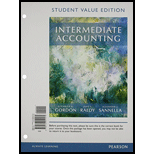
The difference if any in the impairment test for tangible long-term operating assets from intangible assets.
Answer to Problem 12.1Q
Yes the impairment tests for tangible-long term operating assets operating assets and intangible assets are identical, the only difference is, that in case of intangible assets test for impairment is to be conducted even if there is absence of impairment indicators.
Explanation of Solution
Tangible Assets:
Tangible assets are those assets that are physically present in an organization and will generate
Intangible Assets:
Intangible assets are those assets that are not physically present in an organization but have economic values and are capable to generate cash flows for a number of years.
The difference in the both tests can be explained in the points below:
- The impairment tests for tangible-long term operating assets and intangible assets are identical, the only difference is, that in case of intangible assets test for impairment is to be conducted even if there is absence of impairment indicators.
- Impairment is calculated by measuring the asset’s recoverable value, if such value is less than its carrying amount than an impairment loss is booked.
- Recoverable value is greater of (a) Fair value less cost to sell and; (b) Present value of expected cash flows expected from the asset.
Hence, the difference is that intangible assets are considered for impairment even if there is absence of impairment indicators while tangible assets are not.
Want to see more full solutions like this?
Chapter 12 Solutions
Intermediate Accounting - Myaccountinglab - Pearson Etext Access Card Student Value Edition
- Timothy Systems has net working capital of $1,480, long-term debt of $9,650, fixed assets of $13,100, and total assets of $19,740.arrow_forwardI need help finding the accurate solution to this financial accounting problem with valid methods.arrow_forwardI need help solving this general accounting question with the proper methodology.arrow_forward
- Please explain the solution to this general accounting problem with accurate principles.arrow_forwardPlease explain the solution to this general accounting problem with accurate explanations.arrow_forwardVaughn Industries uses a job order cost system and applies overhead based on estimated rates. The overhead application rate is based on total estimated overhead costs of $372,000 and direct labor hours of 9,300. During the month of March 2025, actual direct labor hours of 8,100 were incurred. Use this information to determine the amount of factory overhead that was applied in March.arrow_forward
- Jones Co. had $61,500 in sales during 2025. During the year, Jones purchased $18,400 in inventory. The company began the year with $4,100 in inventory and ended the year with $1,300 in inventory. In addition, during 2025, Jones received a prepayment of $2,500, which was correctly classified as unearned revenue. What was Jones's gross profit during 2025? A. $38,000 B. $40,300 C. $39,600 D. $42,100 E. None of the abovearrow_forwardFinancial Accountingarrow_forwardI need help with this financial accounting question using accurate methods and procedures.arrow_forward
- Principles of Accounting Volume 1AccountingISBN:9781947172685Author:OpenStaxPublisher:OpenStax College
 Auditing: A Risk Based-Approach (MindTap Course L...AccountingISBN:9781337619455Author:Karla M Johnstone, Audrey A. Gramling, Larry E. RittenbergPublisher:Cengage Learning
Auditing: A Risk Based-Approach (MindTap Course L...AccountingISBN:9781337619455Author:Karla M Johnstone, Audrey A. Gramling, Larry E. RittenbergPublisher:Cengage Learning  Intermediate Accounting: Reporting And AnalysisAccountingISBN:9781337788281Author:James M. Wahlen, Jefferson P. Jones, Donald PagachPublisher:Cengage Learning
Intermediate Accounting: Reporting And AnalysisAccountingISBN:9781337788281Author:James M. Wahlen, Jefferson P. Jones, Donald PagachPublisher:Cengage Learning Cornerstones of Financial AccountingAccountingISBN:9781337690881Author:Jay Rich, Jeff JonesPublisher:Cengage Learning
Cornerstones of Financial AccountingAccountingISBN:9781337690881Author:Jay Rich, Jeff JonesPublisher:Cengage Learning




